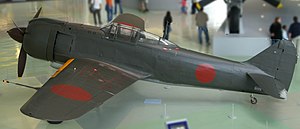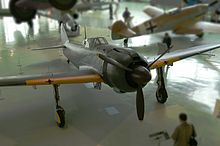| Kawasaki Ki-100 | |
|---|---|
| A Ki-100 in the RAF Museum at Hendon, London | |
| Role | Fighter |
| Manufacturer | Kawasaki Heavy Industries |
| First flight | 1 February 1945 |
| Introduced | 1945 |
| Retired | 1945 |
| Primary user | Imperial Japanese Army Air Force |
| Produced | 1945 |
| Number built | 395 [1] |
| Developed from | Kawasaki Ki-61 |
The emergency measure of adapting a Ki-61-II-KAI fighter to carry a Mitsubishi radial engine resulted in one of the best interceptors used by the Army during the entire war. It combined excellent power and manoeuvrability [2] and, although its high altitude performance against the USAAF B-29 Superfortress heavy bombers was limited by the lack of an efficient supercharger, it performed better than most other IJAAF fighters.[3]
Missions began in March 1945; from the first engagements the Ki-100 performed well against the B-29, and showed itself to be equally effective against U.S. Navy carrier fighters.[4] A new variant, the Ki-100-Ib, was constructed during the last weeks of the conflict in time to to equip five sentai for home defense duties.
Contents
|
Design and development
In mid-1944, the Ki-61 was one of the best fighters of the IJAAF. It was the only production Japanese fighter to have an inline powerplant (the Kawasaki Ha-40, a Japanese adaptation of the German Daimler-Benz DB 601 engine) during World War II, as well as the first one with factory-installed armor and self-sealing fuel tanks. It also had respectable performance, more in line with contemporary American and European designs of the time, with a focus on speed and rate of climb instead of manoeuvrability and range. It was an effective design, but suffered from engine shortages and reliability problems.These problems as well as the performance advantage of enemy fighters, especially the F6F Hellcat, led to the development of an improved model, the Ki-61-II (later Ki-61-II-KAI), powered by the new 1,120 kW (1,500 hp) Kawasaki Ha-140 engine, which was unfortunately heavier than the Ki-61-I-KAIc it replaced. Maximum speed increased from 590 km/h (370 mph) to 610 km/h (380 mph) and general performance (except rate of climb) improved as well. However, it was never able to perform as planned due to the continued degradation of quality of the engine's assembly line, with far fewer engines produced than were required, while many of the engines that were built were rejected due to poor build quality. At this point of the war, the IJAAF was in desperate need of effective interceptors to stop the enemy bomber raids over the Japanese mainland, so in October 1944 it was ordered that a 1,120 kW (1,500 hp) Mitsubishi Ha-112-II (Kinsei ["Venus"] 60 series), a 14-cylinder, two-row radial engine should be installed in those airframes. The need for the re-engined fighter was made yet more urgent on 19 January 1945, when a B-29 raid destroyed the engine's production plant,[5] leaving 275 finished Ki-61s without a powerplant.
The Mitsubishi Ha-112-II some 54 kg (120 lb) lighter than the Ha-140 and produced the same power more reliably. After the study of an imported Fw 190A, an example of an aircraft in which a wide radial engine had been successfully installed in a narrow airframe, three Ki-61-II-KAI airframes were modified to carry this engine and to serve as prototypes. Three engineers, Takeo Doi, chief engineer and head of project, his assistant Makato Owada and head of engine systems at Kawasaki Kagamigahara, Tomio Oguchi, worked through several concepts for redesigning the Ki-61 airframe to accept the new engine before, settling on a solution in which a second skin fairing was riveted to the fuselage, to smooth out the airflow behind the adjustable cooling flaps and multiple exhaust stubs of the new engine cowling.[6]. At first, there were problems with the aircraft now being found to be very tail-heavy, but the removal of a large lead counterbalance, which had been placed in the Ki-61-II-KAI's rear fuselage to balance the increasingly heavy Ha-140 engine, restored the center of gravity (cg).
As a result, on 1 February 1945, the new model was flown for the first time. Without the need for the heavy coolant radiator and other fittings required for a liquid-cooled engine, the Ki-100 was 329 kg (725 lb) lighter than the Ki-61-II, reducing the wing loading from 189 kg/m² (38.8 lb/ft²) to 175 kg/m² (35.8 lb/ft²). This had an immediate positive effect on the flight characteristics, enhancing landing and takeoff qualities as well as imparting increased manoeuvrability and a tighter turning circle.[6]
The army general staff was amazed by the flight characteristics of the plane, which surpassed the Hien's in all but maximum speed (degraded by a maximum of 29 km/h/18 mph by the larger area of the radial engine's front cowling), and the model was ordered to be put in production as the Goshikisen (Go = five; shiki = type; sentoki = fighter) or Army Fighter Type 5. The company's name was Ki-100-1-Ko. All of the airframes were remanufactured from Ki-61-II Kai and Ki-61-III airframes; the integral engine mount/cowling side panel was cut off the fuselage and a tubular steel engine mount was bolted to the firewall/bulkhead. Many of the redundant fittings from the liquid-cooled engine, such as the ventral radiator shutter actuator, were still kept. The first 271 aircraft, or Ki-100-1-Ko, with the raised "razorback" rear fuselage were rolled out of the factory between March and June 1945. A further 118 Ki-100 I-Otsu were built with a cut-down rear fuselage and new rear-view canopy from May through to the end of July 1945. This version also featured a modified oil cooler under the engine in a more streamlined fairing.[6]
The engine was reliable in contrast to the mechanical nightmares of the Nakajima Ki-84, Kawasaki Ki-61, and Kawanishi N1K-J that kept many aircraft grounded.[7] Although slow in level flight for 1945, Ki-100 could dive with P-51 Mustangs (unlike most Japanese fighters) and hold the speed on pullout. Two problems which hampered the effective employment of Japanese fighters towards the end of the war were unreliable electrical systems; that of the Ki-100 was less problematic than most other aircraft types, although the fuse-boxes caused problems; and poor radio communications, which was generic throughout the war.[8]
The armament was two fuselage-mounted 20 mm Ho-5 cannons, each with 200 rpg. These were complemented by two wing-mounted 12.7 mm (.50 in) Ho-103 machine guns with 250 rpg.[9]
Improvement of the basic model lead to the Ki-100-II, with a supercharged engine for high-altitude interception of the B-29 Superfortresses, but only three examples were built, and it never saw combat.[10]
Operational history
Army units to be equipped with this model included the following Sentai: 5th, 17th, 18th, 20th, 59th, 111th, 112th, 200th and 244th and the 81st Independent Fighter Company. Along with the previously-named Army air units, pilots were trained through the Akeno and Hitachi (Mito) Army Flying Schools. Many of the Akeno and Hitachi instructors, who were often seconded from operational units, flew combat missions (this deployment was a notable spreading out of the very few fighters that were operational, but many of these wings were only partially re-equipped).[11]The Ki-100 made its combat debut on the night of 9 March 1945[12][13] and suffered its first loss on 7 April 1945, when a Ki-100 flown by Master Sergeant Yasuo Hiema of the 18th Sentai was shot down by a B-29 after "attacking the formation again and again".[13] Allied aircrews soon realised that they were facing a formidable new fighter[14] Although far fewer Ki-100s were available than the Ki-84s, it was perceived to be one of the most important fighters in the inventory. However in intercepting the high-flying B-29s (at a point in the conflict, the B-29 raids became low-level missions), the new Japanese fighters struggled as the Ha-112-II engine performance decreased at high altitudes. The most effective way to attack the Superfortress was by making very dangerous head-on attacks, changing their approach path as they neared the bombers. A failure while attempting this was deadly, because of the concentration of defensive fire from the bombers. In this type of combat, the Navy's Mitsubishi J2M Raiden was superior.[15]
During March and April 1945 experienced instructors from the Akeno Army Flying School flew the Ki-100 in extensive tests against the Ki-84, which was considered to be the best of the JAAF fighters then in operational service. Their conclusions were that, given pilots of equal experience, the Ki-100 would always win in combat.[16] From Mid-April Major Yasuhiko Kuroe, a highly experienced combat veteran was placed in charge of a "flying circus" made up of captured Allied aircraft, including a Mustang which had been captured in China. This "circus" travelled to various operational fighter bases throughout Japan and was used to train pilots in the best ways to combat enemy aircraft.
On 25 July 1945, 18 Ki-100 fighters from 244th Sentai encountered 10 Hellcats of the light aircraft carrier USS Belleau Wood's Fighter Squadron 31 (VF-31) in an air battle where the Ki-100 pilots claimed 12 victories with only two losses. Claims and counter-claims regarding the "true" results still arise around this action. The real losses were two Hellcats and two Ki-100s, including Major Tsutae Obara's Ki-100 and Ensign Edwin White's Hellcat which collided, killing both pilots.[17]
After the bombing of the Kagamigahara plant and the slow deliveries of components by the satellite plants, production rates of the Ki-100 began to fall more and more, and in the period between May and July, only 12 examples were delivered. Finally, production ended due to the bombing, with only 118 examples of the Army Type-5 Fighter Model 1b delivered.
The last loss of a Ki-100 occurred on 14 August 1945, a day before the surrender of Japan, when Sergeant Major Fumihiko Tamagake of the 244th Sentai was shot down by a Mustang.[11]
An overall assessment of the effectiveness of the Ki-100 rated it highly in agility and a well-handled Ki-100 was able to out-manoeuvre any American fighter including the formidable P-51D Mustangs and the P-47N Thunderbolts which were escorting the B-29 raids over Japan by that time, and was comparable in speed especially at medium altitudes. In the hands of an experienced pilot, the Ki-100 was a deadly opponent and together with the Army's Ki-84 and the Navy's Kawanishi N1K-J, the only other Japanese fighters being able to defeat the latest Allied types.[18]
Variants
- Ki-100 (prototypes): one batch of Kawasaki Ki-61 II KAI with radial engine. 3 built as such.
- Ki-100 I-Ko: Fighter Type 5 of Army (Mark Ia) initial model of series, KI-61 II KAI modified. 271 built as such.
- Ki-100 I-Otsu: (Mark Ib) full-vision canopy. 118 built as such.
- Ki-100 II (prototypes): engine Mitsubishi Ha-112-II Ru with turbocharger, 1,120 kW (1,500 hp). 3 built as such.
- Total production: 395 examples.[1].
Specifications (Ki-100-1a/b Goshikisen)
Data from Japanese Aircraft of the Pacific War [19]
General characteristics- Crew: 1
- Length: 8.82 m (28 ft 11 in)
- Wingspan: 12.00 m (39 ft 4 in)
- Height: 3.75 m (12 ft 4 in)
- Wing area: 20 m² (215 ft²)
- Empty weight: 2,525 kg (5,567 lb)
- Loaded weight: 3,495 kg (7,705 lb)
- Powerplant: 1× Mitsubishi Ha 112-II radial engine, 1,120 kW (1,500 hp) at take off
- Maximum speed: 580 km/h (313 kn, 360 mph) at 6,000 m (19,700 ft)
- Cruise speed: 400 km/h (217 kn, 249 mph)
- Range: 2,200 km (1,189 nmi, 1,367 mi)
- Service ceiling: 11,000 m (36,090 ft)
- Climb to 5,000 m (16,400 ft): 6 min
- Guns: 2 × 20 mm fuselage-mounted Ho-5 cannons, and 2 × 12.7 mm (.50 in) wing-mounted Ho-103 machine guns




No comments:
Post a Comment